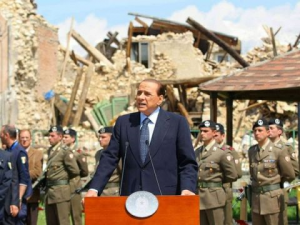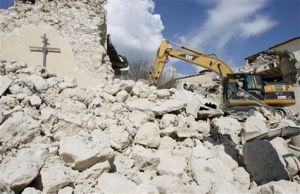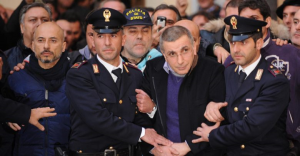Disaster recovery: An opportunity for corruption?
This blog was published by Stefano Piscitelli, MSc International Disaster Management student at the Humanitarian and Conflict Response Institute (HCRI). It was published due to being an assessment piece of the highest calibre amongst the cohort in the Rethinking Recovery course module. The blog relates to the 2009 L’Aquila earthquake in central Italy.
April 6, 2009, at 3.32 am the earth trembles in L’Aquila and a violent series of shocks, the strongest of magnitude 6.3, devastates the city and many areas of the province. A catastrophe that caught the inhabitants in their sleep and razed to the ground houses, monuments, historical buildings, hospitals, universities. The final balance will be 309 victims, 1,600 injured and about 70,000 displaced. During a visit on April 7, 2009, Berlusconi, Italian Former Prime Minister, surrounded by journalists and in the presence of G8 leaders, invited the earthquake victims to go to the sea to “take a break” because the reconstruction would be “quick”, but above all it would be “build back better”. 10 years after the tragedy in L’Aquila, the Italian newspaper, Espresso[1], returned to the areas affected by the earthquake to ask locals what they thought of the reconstruction operations. The most popular answer? “An opportunity for enrichment for the few at the expense of us common people still forced to live in tent.[2]“
In recent disaster literature, the concept of Recovery has been the crutch on which the fragile idea of “Build Back Better” has often leaned, quickly becoming the mantra of the recovery effort, the guiding principle and the lasting promise of every post-disaster phase. However, over the infinite number of contributions and theories that gravitate around the rhetorical package “Build Back Better”, there seems to be no unique model of recovery, just as there is no recipe for “Build Back Better” for everyone and everywhere[3].
Let’s take earthquakes as an example: the vast majority of the speeches conceived and prepared for post-earthquake reconstruction, definitely focuses on the engineering aspect of reality, feeding a reasoning about the city and the areas affected by the earthquake, rather than opening a debate with the earthquake victims and the disaster areas[4]. The focus of the reconstruction discourse is thus focused on things and much less on people. According to the “capitalist fundamentalism” of Friedman – “the occurrence of a great crisis or shock” allows to exploit the resources of the state for personal gain while the inhabitants are still disoriented[5]. Post-disaster situations are in fact united by the responses provided to these emergencies; responses inspired by the theories of Naomi Klein who saw in disasters not so much problems to solve as opportunities for rapid enrichment in favour of a small minority gathered in the cowardly pact between a criminal and corrupt political class and large corporations[6].
Natural disasters are a breeding ground for fraud and corruption, as services are provided quickly and without too much control[7]. The disaster governance structure in Italy is highly corrupt because too many stakeholders are part of the decision-making process[8]; as in every sphere of power, the more concrete the opportunities for profit, the more corruption becomes rampant. Indeed, Ambraseys states that the Recovery phase is a fertile ground for corruption as it is a process characterized by an important flow of economic resources[9]. For some actors, therefore, the recovery phase is conceived as real “windows of opportunity” to make economic profit[10].
What happened during the earthquake in L’Aquila 2009, is the classic Italian story of corruption and cement. Once the state of emergency was declared, the various disaster management agencies, acting as agents of the state, were endowed with emergency powers and later covered by provisions of state secrecy that made them immune to any type of tender or bureaucratic processes. To maximize profits in the millionaire contracts of the so-called private reconstruction, seven entrepreneurs, turned to the Camorra, to get the workers at low prices. The process was this: the workforce was hired by firms in L’Aquila or Campania to work in private post-earthquake reconstruction sites through the intermediation of other builders from Campania who were uncensored but contiguous to the Di Tella di Caserta[11]. The salary was paid with regular pay slips, but half of it was paid in cash to constitute a treasury of black funds for the group from Campania. In the investigation of the public prosecutor’s office it can be seen that the material used by the manufacturers was of very low quality, not even very close to the standards of the EU and the Italian government.
The recovery process, in fact, was severely criticized by an investigation by the European Parliament and the National Anti-Mafia Directorate which accused the misuse of the 493 million euros made available by the European Union. The CASE project, a temporary housing project for displaced people, is a living testimony of this. Designed to be sustainable, anti-seismic and welcoming, it has been realized with the contribution of 350 million of the European Union, while the remaining part has been financed by the Italian state[12]. In the frenzy of reconstruction, the Civil Protection (in charge of disaster management), has omitted the Council of L’Aquila, representatives of the community and various associations from the decisions related to the CASE project and its implementation. Later it was discovered that the Civil Protection colluded in the phase of assignment of some projects, for the value of the works, 560 million euros, commissioned to direct contractors who did not have the anti-mafia certificate and, according to the subsequent investigation, they were the lenders of the Casalese Clan[13].
Disasters are often seen as opportunities for companies to “rebuild better”. But in post-disaster contexts like Aquila’s, “better” is a “loaded term that is often defined according to a neoliberal logic of profit on people”[14]. The globalized Mafia, in fact, acts as a service company that slips into the grey zone of the capitalist-neoliberal economy and uses tragedies for personal enrichment. Ten years after the earthquake, the reconstruction has not yet been completed. In the era of climate change, there is a strong recognition of the relationship between corruption, natural disaster and the Recovery phase. Preventing or limiting the access of criminal groups to places affected by disasters is fundamentally a reason for prevention. A solid government strategy would also serve to reduce the damage; many victims of disasters are caused by poor construction or absences in monitoring quality standards before the disaster occurs[15].
References:
[1] https://m.espresso.repubblica.it/video/tutti-i-video/l-aquila-non-deve-morire-marco-damilano-presenta-l-video-in-edicola-da-domenica-31-marzo/12767/12863
[2] https://www.lastampa.it/cronaca/2019/04/06/news/bertolaso-a-dieci-anni-dall-aquila-io-una-casa-l-ho-data-ai-terremotati-1.33693366
[3] Joakim, E. (n.d.). Post-Disaster Recovery and Vulnerability.
[4] Maly, E. (2017). Rethinking “Build Back Better” in housing reconstruction: A proposal for “People Centered Housing Recovery.”
[5] Singer, R. (2010). Neoliberal Style, the American Re-Generation, and Ecological Jeremiad in Thomas Friedman’s “Code Green.” Environmental Communication, 4(2), pp.135–151.
[6] Klein, N. (2007). The shock doctrine : The Rise of Disaster Capitalism. Random House of Canada.
[7] Green, P. (2005). Disaster by design: corruption, construction and catastrophe. British Journal of Criminology,
[8] Saviano, R. (2006). Gomorra : Viaggio nell’impero e nel sogno di dominio della camorra. Milano: Mondadori.
[9] Ambraseys, N. and Bilham, R. (2011). Corruption kills. Nature, 469(7329), pp.153–155.
[10] Manyena, S.B. (2013). Disaster event: Window of opportunity to implement global disaster policies? Jàmbá: Journal of Disaster Risk Studies, 5(1).
[11] https://www.ilfattoquotidiano.it/2014/06/25/terremoto-i-casalesi-nella-ricostruzione-dellaquila-arrestati-7-imprenditori/1039102/
[12] Gatti F. (2019). Terremoto Aquila: Dieci anni di Beffe. (Online) https://espresso.repubblica.it/plus/articoli/2019/03/27/news/l-aquila-terremoto-10-anni-dopo-fabrizio-gatti-1.333142
[13] Longhini, A. (2013). The L’Aquila Earthquake: assessing the EU and Italian intervention. [online] pp.11–16.
[14] Sou, G. (n.d.). Barbudans are resisting “disaster capitalism”, two years after Hurricane Irma. [online] The Conversation.
[15] Sergi, A. and Springer International Publishing Ag (2018). From Mafia to Organised Crime A Comparative Analysis of Policing Models. Cham Springer International Publishing Palgrave Macmillan.






0 Comments